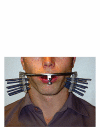A randomized, double-blind crossover trial of paracetamol 1000 mg four times daily vs ibuprofen 600 mg: effect on swelling and other postoperative events after third molar surgery
- PMID: 12680890
- PMCID: PMC1884233
- DOI: 10.1046/j.1365-2125.2003.01779.x
A randomized, double-blind crossover trial of paracetamol 1000 mg four times daily vs ibuprofen 600 mg: effect on swelling and other postoperative events after third molar surgery
Abstract
Aims: To evaluate the effect of a 3-day regimen of ibuprofen 600 mg x 4 on acute postoperative swelling and pain and other inflammatory events after third molar surgery compared with a traditional regimen of paracetamol 1000 mg x 4.
Methods: A controlled, randomized, double-blind, cross-over study where 36 patients (26 females, 10 males) with mean age 23 (range 19-27) years acted as their own controls. All patients were subjected to surgical removal of bilateral third molars. After one operation the patients received tablets of ibuprofen 600 mg x 4 for 3 days. After the other operation they received an identical regimen of paracetamol 1000 mg tablets. Swelling was objectively measured (mm) with a standardized face bow and the patients scored their pain intensity (PI) on a 100-mm visual analogue scale.
Results: There was no statistically significant difference between paracetamol and ibuprofen treatment with respect to effect on acute postoperative swelling. Swelling after paracetamol on the third postoperative day was 1.8% less than that after ibuprofen. Mean (95% CI) difference between treatments was -0.3 (-4.7, 4.1) mm. On the sixth postoperative day swelling after ibuprofen was 2.3% less than that after paracetamol. Mean (95% CI) between treatments was 0.2 (-2.4, 2.8) mm. There was no statistically significant difference in pain intensity between the paracetamol and the ibuprofen regimen on the day of surgery. The mean (95% CI) difference between the treatments for summed pain intensity on the day of surgery (SUMPI 3.5-11) was 3.31 (-47.7, 54.3) mm. Two patients developed fibrinolysis of the blood clot (dry socket) after receiving ibuprofen while none did this after paracetamol treatment. There was no noticeable difference between treatments with respect to appearance of haematomas/ecchymoses or adverse effects which all were classified as mild to moderate.
Conclusions: A 3-day regimen of ibuprofen 600 mg x 4 daily does not offer any clinical advantages compared with a traditional paracetamol regimen 1000 mg x 4 daily with respect to alleviation of acute postoperative swelling and pain after third molar surgery.
Figures




References
-
- Collins SL, Moore RA, McQuay HJ, Wiffen PJ. Oral ibuprofen and diclofenac in postoperative pain: a quantitative systematic review. Eur J Pain. 1998;2:285–291. - PubMed
-
- Li Wan Po A, Zhang WY. Analgesic efficacy of ibuprofen alone and in combination with codeine or caffeine in post-surgical pain: a meta-analysis. Eur J Clin Pharmacol. 1998;53:303–311. - PubMed
-
- Cooper SA. Five studies on ibuprofen for postsurgical dental pain. Am J Med. 1984;77(1A):70–77. - PubMed
-
- Forbes JA, Kehm CJ, Grodin CD, Beaver WT. Evaluation of ketorolac, ibuprofen, acetaminophen, and an acetaminophen-codeine combination in postoperative oral surgery pain. Pharmacotherapy. 1990;10:94S–105S. - PubMed
-
- Cooper SA, Schactel BP, Goldman E, Gelb S, Cohn P. Ibuprofen and acetaminophen in the relief of acute pain: a randomized, double-blind, placebo-controlled study. J Clin Pharmacol. 1989;29:1026–1030. - PubMed
Publication types
MeSH terms
Substances
LinkOut - more resources
Full Text Sources
Medical
Research Materials
Miscellaneous

